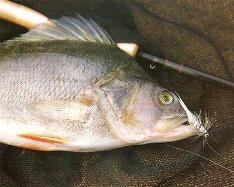

Catching fish on the fly, not many things are more exhilarating in the fishing sphere.Catching fish on the fly will test your skills and abilities to the limit, but you have to know what to use for the fish you want to catch in great detail other wise you will waste a lot of time and energy catching nothing.
What fish can you expect to catch? At sometime or another all fish will take a fly or an insect off the surface, as the picture on the right testifies to, this perch was taken on a fly. This is not the normal result you would expect when you cast the fly out.
At sometime or another all fish will take a fly or an insect off the surface, as the picture on the right testifies to, this perch was taken on a fly. This is not the normal result you would expect when you cast the fly out.
Here we will give you an insight into what you need to look out for on, in or around the water to help you catch your quarry.
Firstly you have to know what your quarry is. We are going to look here at the usual suspects - namely Trout, Grayling, Salmon and the more resent additions to the fly fishing world, Pike and Bass TroutThe Trout is probably the fish most fished for on the fly, be it on stocked water or in a naturally stocked river, some species of the Trout is fished all over the world. Although Trout will take flies of the surface, they do most of their eating below the surface. To this end wet flies are the most suited technique to use. The water conditions you are fishing will have an impact on the method of wet fly you employ. When you are retrieving the line you want to make the Trout believe that this is a real fly and take it. To do this you have to mimic the behaviour of the fly in the water. We do this by holding the rod up high and drawing the line back through the rod rings, forcing the fly to pull back through the water like the fly struggling to get to the surface. If the water is flowing you want to use the down and across method. So how do you know where the Trout areIt is a good time now to look at where the Trout might be in the water. When dealing with Trout in a river you have to look for places where the Trout can shelter from the current but still be in position to grab any food that comes its way Even though the flow maybe fast the Trout is still cautious and will have a good look before taking the food.GraylingSalmonPikePike fly fishing is a new development in the fly fishing world.Bassfly fishing for Smallmouth Bass, fly fishing for Largemouth Bass
SORRY THIS PAGE IS STILL UNDER CONSTRUCTION PLEASE VISIT IT IS A COUPLE OF DAYS WHEN IT SHOULD BE COMPLETEDidn't Find What You Were Looking For?I am sorry to hear that - Please use the search below to look for information on fish on the fly again. Note this will open a new browser window.
Custom Search
Back to Fish on the Fly Top Back to Fly Fishing/A> > Back to Home |






















